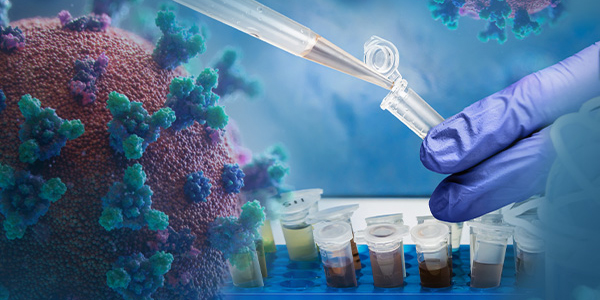
Wastewater-based epidemiology (WBE), or sewershed surveillance, is the analysis of wastewater to identify the presence of biologicals or chemicals for the purpose of monitoring public health. In the past, WBE has been used to detect the presence of pharmaceutical or industrial waste, drugs and viruses. Now, it is seen as a valuable tool to monitor COVID-19 outbreaks.
WBE has several advantages compared to diagnostic testing. First of all, it is much more cost-efficient in obtaining population-wide data. One wastewater sample can provide data on the average infection rate of thousands of people. Another advantage is early detection. Studies show that SARS-CoV-2 genetic material can be detected in human feces a week before the individual shows any symptoms. Finally, WBE data is unbiased and better represents the true circulation of virus within a population. In contrast, only a fraction of COVID-19 patients take a diagnostic test.
Although WBE has many advantages, the results rely heavily on the method of wastewater sample pretreatment. Because the viral material is highly diluted in wastewater samples, a concentration step is required before the sample can be tested. SARS-CoV-2 is an enveloped virus, which means the viral genetic material is protected within a lipid bilayer. Most existing concentration techniques, including polyethylene glycol (PEG) precipitation and ultracentrifugation, were developed to concentrate non-enveloped viruses (e.g., norovirus and adenovirus). Using these concentration methods for SARS-CoV-2 could result in lower recovery efficiency.
In a recent study, Robotto et al. at the Environmental Protection Agency of Piedmont in Italy tested a new workflow for monitoring SARS-COV-2 in wastewater. The workflow, developed by Promega, involves two main steps: direct total nucleic acid (TNA) capture and RT-qPCR detection. TNA capture is done using a Promega TNA kit, which includes required purification columns and reagents. First, 40ml of wastewater is passed through a Midi-column. The TNA is captured on the column and eluted. The eluted TNA is then further purified and concentrated in 40μl volume. For detection, they used the Promega SARS-CoV-2 RT-qPCR Kit (N1, N2 and E targets). The kit includes two analytical process controls: 1) primers for detecting Pepper Mild Mottle Virus (PMMoV; an RNA virus commonly found in feces), which simultaneously allow normalization of the data; and 2) an internal amplification control to check that there are no PCR inhibitors present during amplification, to avoid false negatives.
Results showed that the recovery efficiency of the nucleic acid capture method was 50%, which is higher than previously reported for PEG precipitation (44%) and ultracentrifugation (33.5%). The overall limit of detection was 1,200 genetic copies per liter of raw wastewater, which is highly sensitivity compared to other reports. Not only is the capture method efficient and sensitive, it is also faster than traditional methods, taking less than 2 hours to complete. The RT-qPCR kit also demonstrated high specificity, with no amplification detected in control samples.
Using this method, Robotto et al. analyzed almost 500 wastewater samples collected from four wastewater treatment plants in the Piedmont region of northwestern Italy. The samples were collected over the course of six months, from September 2020 to March 2021. The data showed a strong correlation between the SARS-CoV-2 concentration in wastewater and the average number of COVID-19 cases in the same area that were reported 7—21 days later. This result provides strong evidence that data produced using this new workflow can accurately predict future outbreaks.
The WBE data also revealed increased viral spread that was previously undetected. For example, the WBE data showed a slight uptick of SARS-CoV-2 concentration over the December holiday season that was not detected by official testing, likely due to reduced testing over the holidays. Thus, WBE can be a useful approach to complement diagnostic testing.
In summary, this study shows that the Promega WBE workflow is a reliable method for monitoring COVID-19. Even as more people are being vaccinated, new emerging variants still pose a risk, and wastewater surveillance would be critical for monitoring these variants. WBE can also help determine whether vaccines can effectively reduce the circulation of SARS-CoV-2 within the population. Most experts agree that COVID-19 is here to stay, and WBE will be an important strategy to manage the disease in this new normal.
Learn more about how we can support SARS-CoV-2 wastewater surveillance!
Reference: Robotto, A. et al. (2021) Wastewater-based SARS-CoV-2 environmental monitoring for Piedmont, Italy. Environ Res. 203, 111901.
Latest posts by Johanna Lee (see all)
- Microfluidic Organoids Could Revolutionize Breast Cancer Treatment - March 25, 2025
- Bacteria From Insect Guts Could Help Degrade Plastic - January 28, 2025
- A Diabetes Drug, Metformin, Slows Aging in Male Monkeys - December 19, 2024
